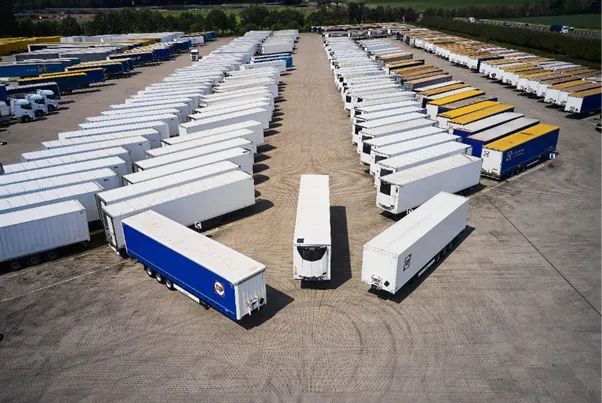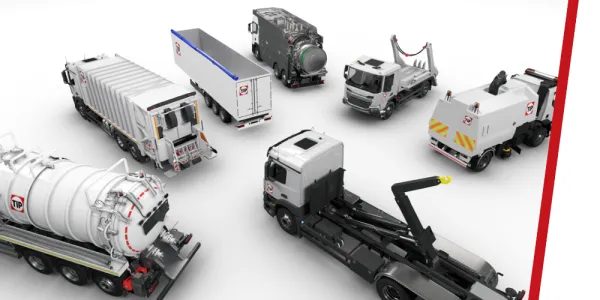Fleet management reimagined: from vehicles to capital strategy
Fleet management reimagined: from vehicles to capital strategy
TIP Group CEO Arjen Kraaij on Why the Boardroom Is Paying Attention
“By treating the fleet as a strategic asset rather than a cost centre, companies can unlock capital for growth”
“It’s not just about keeping trailers and trucks on the road anymore. Every decision, how you finance your assets, how long you keep them, when you replace them, directly impacts your financing structure, your risk profile, your ESG score and ultimately your return on capital. For many companies, fleet costs are among the biggest drivers of total expenses, and even a small improvement can have a major impact on the bottom line. That’s why it has become a shared responsibility across the business, from executives to fleet managers,” says Arjen Kraaij, TIP Group’s CEO as of 10 December 2025.
In this article, Kraaij shares his perspective, based on decades of experience in fleet management. He argues that effective asset management can strengthen a company's bottom line margin by improving capital efficiency, reducing risk exposure, and aligning operational and financial decision-making. By treating the fleet as a strategic asset rather than a cost centre, companies can unlock capital for growth, maintain flexibility in volatile markets, and make smarter choices about ownership, leasing and lifecycle management.

Increasing complexity of fleet management
“For years, fleet management was something companies didn’t have to think much about,” Kraaij says. “Margins were predictable, relationships with suppliers were steady, and the business model felt safe, so there was no urgency to change, until costs started rising and volatility exposed the limits of that model,” Kraaij says. “You used to buy your trailers for roughly the same price each year, financing was cheap, and maintenance could be done almost anywhere. It was a given, an operational task that had to be managed. The fleet manager handled it, and the CFO had to sign off on a few new trailers. No business case necessary, that’s just how things were done.”
“But that world has changed completely,” he continues. “Maintenance has become a real challenge: where do you get it done, who has the people, and what does it cost? Equipment prices are up 30 to 40 per cent, electric trucks cost two or three times as much as diesel ones, and suddenly every purchase decision feels heavier. You can no longer just walk into a dealer and order five new trucks. You have to consider: how do I finance this, do I lease or buy, what’s the residual value, how do I maintain them, how do I organise and avoid the cost of downtime and kilometres to the nearest workshop?”
Asset management driving higher return on capital
“Flexible asset models are first and foremost a financial instrument,” Kraaij explains. “If you’re focused on return on assets or return on capital employed, you have every reason to keep your balance sheet as light as possible. Because you’re generating the same profit with less capital employed. Companies are increasingly looking for ways to finance their fleets off-balance. It gives them flexibility, protects liquidity, and keeps their capital free for growth. Leasing, rental or pay-per-use models allow operators to scale their fleets up or down without tying up funds in equipment.”
“At the same time, the financial picture is increasingly shaped by operational realities. Digital tools now create a vital connection between daily operations and financial outcomes, turning routine operational data into actionable insight. Such as performance monitoring and predictive maintenance, directly improving cost control and equipment availability. But insights from data go further and are essential for financial decision-making to help determine when to replace, refurbish or sell assets, and how to finance them most effectively. This allows leaders to make better strategic decisions about their assets and turn operational data into real financial value.”
For Kraaij, including ESG considerations in the decision-making process is only natural. And it also marks the point where financial and sustainability objectives start to converge, reflected by a proven asset management model, refurbishment.

Refurbishment as a financial and ESG lever
“Refurbishment is no longer a workshop decision; it’s a management decision,” says Kraaij. “Economically, the reality is straightforward: when equipment prices and interest rates are higher, refurbishing an existing trailer delivers a lower total cost per kilometre than buying new. That difference is material for any CFO. But refurbishment isn’t just about cost savings. It also links directly to sustainability and capital allocation. Every trailer you refurbish extends its useful life, reduces depreciation, and lowers the embedded emissions from production.
In practice, most companies prefer to outsource refurbishment rather than manage it themselves,” Kraaij explains. “It’s not just about the technical work, it’s about avoiding maintenance risk and keeping cost predictability. A typical approach is to sell six or seven year old assets to a specialist partner at a fair price, they have them refurbished and lease them back for a fixed monthly amount. From a capital perspective, refurbishment reduces the amount invested and the interest burden. Yes, maintenance costs will be higher than with a brand new unit, but overall, the economics are stronger. And capital remains available for other priorities.”
“Long term contracts can embed this logic,” Kraaij continues. “We include mid-life refurbishment in multi-year programmes, such as a fifteen-year lease with refurbishment around year eight. This way, performance and cost are secured from the start. And we can, of course, further support decision making through data.”
Strengthening your company’s performance
“The complexity of managing a fleet will only increase,” Kraaij says. “Environmental regulation is tightening across Europe, and every new rule adds to the cost of running and maintaining equipment. The VECTO framework, for instance, will most likely raise the cost of trailers further. It’s a reality we have to adapt to, and it means companies need to prepare for a new level of financial and operational planning.”
He continues: “If you add all that up, the picture is clear. Fleet management is no longer just about buying, maintaining and selling vehicles. It now extends into capital strategy, risk management and regulatory planning as part of a broader asset management approach. It has become a strategic discipline that also belongs to the CEO’s and CFO’s agenda. I see TIP Group’s role as helping our customers make that shift. We're giving companies the insight and control they need to free up capital, manage risk more effectively, and align financial and operational goals in a way that directly strengthens their company's performance."









